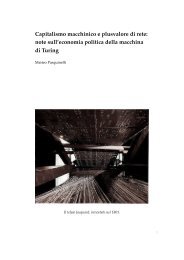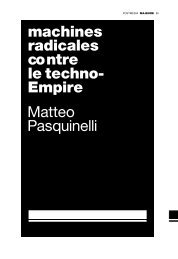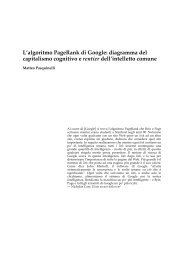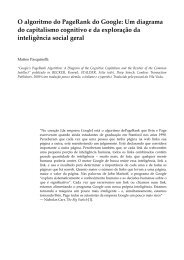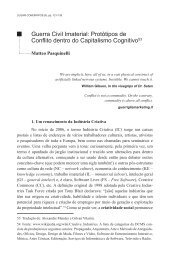Immaterial Civil War - Matteo Pasquinelli
Immaterial Civil War - Matteo Pasquinelli
Immaterial Civil War - Matteo Pasquinelli
Create successful ePaper yourself
Turn your PDF publications into a flip-book with our unique Google optimized e-Paper software.
<strong>Immaterial</strong> <strong>Civil</strong> <strong>War</strong>Prototypes of Conflict withinCognitive Capitalism<strong>Matteo</strong> <strong>Pasquinelli</strong>Barcelona, September 2006
So far it seems a linear scenario, but there is also a grey zone to take inconsideration: the massification of the “creative” attitude. “Everyone is acreative” is a common slogan today. Many years after Benjamin’s artwork, themass artist enters the age of his social reproducibility and “creativity” is soldas a status symbol. The social base of Creative Industries is getting bigger (atleast in the Western world) and unveils new scenarios. In a first period,Creative Industries become hegemonic (as a fact and as an concept). In asecond one, they face an entropy of meaning and producers. Thanks to theinternet and the digital revolution, everyday we witness the conflicts of thelatter stage.All the different schools previously introduced focus each on a differentperspective. To clarify the subject we have to explode the question in itscomponents. The “creative thing” could be dismantled in: creative labour (asautonomous or dependent work), creativity as faculty and production, thecreative product (with all its layers: hardware, software, knoware, brand, etc.),the free reproducibility of the cognitive object, the intellectual property on theproduct itself, the social creativity behind it, the process of collectivevalorisation around it. Moreover, the social group of creative workers (the“creative class” or “cognitariat”), the “creative economy” and the “creativecity” represent further and broader contexts.The original definition of Creative Industries focus on the intellectualproperty exploitation. Richard Florida’s concepts of creative class and creativeeconomy are based on (controversial) statistics only and on the idea of apolitical agenda for CI fuelled by local governments. On another level,Creative Commons is about open licences, a formal solution to handle the freereproduction and sharing triggered by the digital revolution on a mass scale(“building a layer of reasonable copyright” 2 as they put it). Coming from adifferent (Latin) background, the post-Operaism and the precarious workersmovement point out the social and distributed form of production (Tronti’s“social factory” 3 ) and ask for a guaranteed minimum income. Geographicallyclose to the last ones, Enzo Rullani (initiator of the term ‘cognitive capitalism’)suggests to focus on the autonomous power of producers rather than on thedimension of dependent labour, as public welfare is a solution that transfersknowledge, risk and innovation capital to institutions. Such a disambiguationof political views around CI is needed to clarify what the present essay is notcovering. I will not focus on the labour conditions of (precarious) cognitiveworkers, on the exploitation of intellectual property an on the legal protectionof the public domain, but on the collective production of value and the strongcompetition cognitive producers face in the “immaterial” domain.4
3. Lazzarato reading Tarde: the public dimension of valueContemporary criticism does not have a clear perspective of the public life ofcognitive products: it is largely dominated by the metaphors stolen fromCreative Commons and Free Software, which support quite a flat vision withno notion of value and valorisation. For this reason, I want to introduce a moredynamic scenario following Maurizio Lazzarato and Gabriel Tarde thatexplain how value is produced by an accumulation of social desire andcollective imitation. Lazzarato has re-introduced the thought of the Frenchsociologist Tarde in his book Puissances de l'invention 4 [Powers of invention]and in his article “La psychologie économique contre l’economie politique” 5 .To sum up in few lines, Tarde’s philosophy challenges thecontemporary political economy because it: 1) dissolves the opposition ofmaterial and immaterial labour and consider the “cooperation between brains”a main force in the traditional pre-capitalist societies not only in postfordism;2) puts innovation as the driving force instead of monetary accumulation only(Smith, Marx and Schumpter did not really understand innovation as aninternal force of capitalism, a vision more concerned about re-production ratherthan production); 3) develops a new theory of value no more based on usevalueonly, but also on other kinds of value, like truth-value and beauty-value(Lazzarato: “The economic psychology is a theory of the creation andconstitution of values, whereas political economy and Marxism are theories tomeasure values” 6 ).Tarde’s crucial insight for the present work is about the relationbetween science and public opinion. As Lazzarato put it: “According to Tarde,a invention (of science or not) that is not imitated is not socially existent: to beimitated an invention needs to draw attention, to produce a force of ‘mentalattraction’ on other brains, to mobilise their desires and beliefs through aprocess of social communication. […] Tarde figures out an issue crossing allhis work: the constituent power of the public.” 7 We could say: any creativeidea that is not imitated is not socially existent and has no value. In Tarde thePublic is the “social group of the future”, integrating for the first time massmedia as an apparatus of valorisation in a sort of anticipation of postfordism.Moreover Tarde considers the working class itself as a kind of “publicopinion” that is unified on the base of common beliefs and affects rather thancommon interests.The Tarde-Lazzarato connection introduces a dynamic or bettercompetitive model, where immaterial objects have to face the laws of thenoosphere – innovation and imitation – in quite a Darwinistic environment.Tarde is also famous for introducing the S-shaped curve to describe theprocess of dissemination of innovation, another good suggestion for all thedigital planners that believe in a free and flat space.5
However a dissemination process is never as linear and peaceful as amathematical graph might suggest. On a collective scale a cognitive productalways “fights” against other products to attain a natural leadership. Thedestiny of an idea is always hegemonic, even in the “cooperation betweenbrains” and in the digital domain of free multiplication. The naturalenvironment of ideas is similar to the state of nature in Hobbes. The mottoHomo homini lupus [the man is a wolf to man] could be applied to media,brands, signs and any kind of “semiotic machines” of the knowledgeeconomy. It is an immaterial but not often silent “war of all ideas against allideas.” If Lazzarato and Tarde track back the collective making of value, sucha competitive nature is more transparent reading Enzo Rullani.4. Enzo Rullani and the “law of diffusion”Rullani was among the first to introduce the term cognitive capitalism 8 . Unlikemost, he does not point out the process of knowledge sharing, but above allthe process of cognitive valorisation. He is quite clear about the fact thatcompetition still exists (is perhaps even stronger) in the realm of “immaterial”economy. Rullani is one of few people that try to measure how much valueknowledge produces and as a seasoned economist he gives mathematicalformulas as well - like in his book Economia della conoscenza [Economy ofKnowledge] 9 . Rullani says that the value of knowledge is multiplied by itsdiffusion, and that you have to learn how to manage this kind of circulation.As Rullani puts it, in the interview with Antonella Corsani published onMultitudes in 2000 10 :An economy based on knowledge is structurally anchored to sharing:knowledge produces value if it is adopted, and the adoption (in that format andthe consequent standards) makes interdependency.The value of immaterial objects is produced by dissemination andinterdependency: there is the same process behind the popularity of a pop starand behind the success of a software. The digital revolution made thereproduction of immaterial objects easier, faster, ubiquitous and almost free.However, as Rullani points out, “proprietary logic does not disappear but hasto subordinate itself to the law of diffusion” 11 : proprietary logic is no longer basedon space and objects, but on time and speed.6
There are three ways that a producer of knowledge can distribute its uses, stillkeeping a part of the advantage under the form of: 1) a speed differential inthe production of new knowledge or in the exploitation of its uses; 2) a controlof the context stronger than others; 3) a network of alliances and cooperationcapable of contracting and controlling modalities of usage of knowledgewithin the whole circuit of sharing.A speed differential means: “I got this idea and I can handle it better thanothers: while they are still becoming familiar with it, I develop it further”. Abetter understanding of the context is something not easy to duplicate: it isabout the genealogy of the idea, the cultural and social history of a place, theconfidential information accumulated in years. The network of alliances iscalled sometimes “social capital” and is implemented as “social networks” onthe web: it is about your contacts, your PR, your street and web credibility.Here it is clear that a given idea produces value in a dynamicenvironment challenged by other forces and other products. Any idea lives ina jungle – in a constant guerrilla warfare – and cognitive workers follow oftenthe destiny of their brainchildren. In the capitalism of digital networks time isa more and more crucial dimension: a time advantage is measured in seconds.Moreover, in the society of white noise the rarest commodity is attention. Aneconomy of scarcity exists even in the cognitive capitalism as a scarcity ofattention and related attention economy. When everything can be duplicatedeverywhere, time becomes more important than space.An example of the competition advantage in the digital domain is theWired CD included with the November 2004 issue under the CreativeCommons licences. Music tracks were donated by Beastie Boys, David Byrne,Gilberto Gil, etc. for free copying, sharing and sampling (see:www.creativecommons.org/wired). The neoliberal agenda of Wired magazineprovides the clear coordinates for understanding that operation. Indeed, thereare more examples of musicians and brain workers that associate their activitywith copyleft, Creative Commons or file sharing on P2P networks. We onlyheard about the first runners, as it is no longer a novelty for those who camesecond. Anyway, there never is a total adherence to the Creative Commonscrusade, it is always a hybrid strategy: I release part of my work as open andfree to gain visibility and credibility, but not the whole work. Another strategyis that you can copy and distribute all this content, but not now, only in fourmonths. And there are also people complaining about Creative Commons andFree Software being hijacked by corporations and majors - the point is that theworld out there is full of bad music which is free to copy and distribute. Noscandal, we have always suspected it was a race.Rullani shows how competition is still present in the knowledgeeconomy, even in the parallel enclave of digital commons. Competition is afield radical thought never attempted to enter: because it is not politicallycorrect to admit such a competition and because any political solution iscontroversial. It is impossible to reconstruct any unified political subject (as atthe times of proletariat) starting from such a balkanised scenario of “socialfactories” and molecular biopolitical production. However, if individualsurplus-value is difficult to measure and reclaim, the collective accumulationis still something visible and tangible.7
5. David Harvey and the collective symbolic capitalIf Tarde, Lazzarato and Rullani are useful for framing the competitive habitatof ideas (dissemination, imitation, competition, hegemony), David Harvey’sessay “The Art of Rent” 12 introduces a clearer description of the politicaldimension of symbolic production. He manages to link intangible productionand real money not through intellectual property but by tracking the parasiticexploitation of the immaterial domain by the material one.The key example is Barcelona, where there is the clearest connectionbetween real estate economy and the production of culture as social capital.The success of Barcelona as an international brand has been created by itscultural and social roots and is continuously fuelled today by a cosmopolitanand alternative culture: in fact, that collective product is exploited first andforemost by real estate speculators. The kinds of gentrification processes arewell known. Bottom-up: outsiders attract artists that attract gentry. Or, on thecontrary, top-down: open-minded and futuristic art institutions built in aghetto (like the MACBA in the Raval in Barcelona) raise rents and force peopleto move. However, Harvey wants to point out a more general process.Harvey applies the concept of monopoly rent to culture: “All rent isbased on the monopoly power of private owners of certain portions of theglobe.” There are two kinds of rent: you can exploit the unique quality of awine or you can see the vineyard producing that extraordinary wine. You canput a hotel in a very charming city, or selling the land where to put hotels likethat. Capitalism is always looking for marks of distinction. According toHarvey culture produces today the marks of distinction that capitalism canexploit selling material goods. On a city scale, real estate business is thebiggest business triggered by knowledge economy. Any immaterial space hasits material parasites. Think about files sharing and iPods.If the degree of dissemination makes the value of a cognitive product,as Rullani points out, Harvey put a limit to that valorisation. Disseminationthat goes too far can dissolve the marks of distinction into a mass product.There is an entropic ending in any idea after its hegemonic period. Harveyhighlights the first contradiction: the entropy of the marks of distinction:The contradiction here is that the more easily marketable such items becomethe less unique and special they appear. In some instances the marketing itselftends to destroy the unique qualities (particularly if these depend on qualitiessuch as wilderness, remoteness, the purity of some aesthetic experience, andthe like). More generally, to the degree that such items or events are easilymarketable (and subject to replication by forgeries, fakes, imitations orsimulacra) the less they provide a basis for monopoly rent. […] therefore,some way has to be found to keep some commodities or places unique andparticular enough (and I will later reflect on what this might mean) tomaintain a monopolistic edge in an otherwise commodified and often fiercelycompetitive economy.8
A second contradiction connected to the first is the tendency towardsmonopoly: if the value inflates, the only way to preserve the rent is to set upmonopolies and avoid competition. For example, the digital and networkrevolution has attacked traditional monopoly rents (used to quite stable‘territories’) and forced them to reinvent their strategies. The common reactionwas to reclaim a stronger regime of intellectual property. On another level,capitals were forced to find new material and immaterial territories to exploit.Harvey notices that capitalism rediscovers local cultures to preservemonopolies: the collective and immaterial sphere of culture is a crucialdimension to maintain marks of distinction in a postfordist economy.They have particular relevance to understanding how local culturaldevelopments and traditions get absorbed within the calculi of politicaleconomy through attempts to garner monopoly rents. It also poses thequestion of how much the current interest in local cultural innovation and theresurrection and invention of local traditions attaches to the desire to extractand appropriate such rents.The cultural layer of Barcelona and its unique local characters are a keycomponent in the marketing of any Barcelona-based product, first of all thereal estate business. But the third and most important contradiction discoveredby Harvey is that global capital feeds local resistance to promote mark ofdistinction.Since capitalists of all sorts (including the most exuberant of internationalfinanciers) are easily seduced by the lucrative prospects of monopoly powers,we immediately discern a third contradiction: that the most avid globalizerswill support local developments that have the potential to yield monopolyrents even if the effect of such support is to produce a local political climateantagonistic to globalization!Again it is the case of Barcelona, quite a social-democratic model of businessthat is not so easy to apply to other contexts. At this point Harvey introducesthe concept of collective symbolic capital (taken from Bourdieu) to explainhow culture is exploited by capitalism. The layer of cultural productionattached to a specific territory produces a fertile habitat for monopoly rents.If claims to uniqueness, authenticity, particularity and speciality underlie theability to capture monopoly rents, then on what better terrain is it possible tomake such claims than in the field of historically constituted cultural artefactsand practices and special environmental characteristics (including, of course,the built, social and cultural environments)? […] The most obvious example iscontemporary tourism, but I think it would be a mistake to let the matter restthere. For what is at stake here is the power of collective symbolic capital, ofspecial marks of distinction that attach to some place, which have a significantdrawing power upon the flows of capital more generally.9
The collective symbolic capital of Barcelona is shaped more clearly now. Thebrand of Barcelona is a “consensual hallucination” produced by many butexploited by few. The condition of the creative workers (and of the wholesociety) is a vicious circle: they produce symbolic value for the real estateeconomy that squeeze them (as they suffer the housing price of Barcelona).Furthermore, Harvey helps to understand better Florida: the so-called“creative class” is nothing but a simulacrum of the collective symbolic capitalto raise the marks of distinction of a given city. The “creative class” is thecollective symbolic capital transformed into an anthropomorphic brand and amonopoly rent applied to distinctive parts of the society (“creative class”), ofthe territory (“creative city”), of the city itself (“creative district”). The“creative class” is a parasitic simulacrum of the social creativity that isdetached from the precariat and attached to the upper class.The rise of Barcelona to prominence within the European system of cities hasin part been based on its steady amassing of symbolic capital and itsaccumulating marks of distinction. In this the excavation of a distinctivelyCatalan history and tradition, the marketing of its strong artisticaccomplishments and architectural heritage (Gaudi of course) and itsdistinctive marks of lifestyle and literary traditions, have loomed large, backedby a deluge of books, exhibitions, and cultural events that celebratedistinctiveness. […] This contradiction is marked by questions and resistance.Whose collective memory is to be celebrated here (the anarchists like theIcarians who played such an important role in Barcelona’s history, therepublicans who fought so fiercely against Franco, the Catalan nationalists,immigrants from Andalusia, or a long-time Franco ally like Samaranch)?Harvey tries to sketch out a political response questioning which parts ofsociety are exploiting symbolic capital and which kinds of collective memoryand imaginary are at stake. Symbolic capital is not unitary but a multiple spaceof forces, and can be continuously negotiate by the multitude that produced it.It is a matter of determining which segments of the population are to benefitmost from the collective symbolic capital to which everyone has, in their owndistinctive ways, contributed both now and in the past. Why let the monopolyrent attached to that symbolic capital be captured only by the multinationalsor by a small powerful segment of the local bourgeoisie? […] The struggle toaccumulate marks of distinction and collective symbolic capital in a highlycompetitive world is on. But this entrains in its wake all of the localizedquestions about whose collective memory, whose aesthetics, and who benefits.[…]. The question then arises as to how these cultural interventions canthemselves become a potent weapon of class struggle.The crucial question is: how to develop a symbolic capital of resistance thatcan not be exploited as another mark of distinction? As Harvey points thiskind of vicious circle works even better in the case of local resistance. Globalcapitals need anti-global resistance to improve the monopoly rent. Especiallyin the case of creative workers resistance is always well-educated and welldesigned:and in the case of Barcelona it produces a titillating and neverdangerous environment for the global middle-class. Inspired by the history ofBarcelona, we introduce an immaterial civil war into the space of symboliccapital.10
6. ICW - <strong>Immaterial</strong> civil warWe suggest the term ‘civil war’ as conflicts within cognitive capitalism have noclear class composition and share the same media space. Moreover, if it is truethat “there is no more outside” (as Negri and Hardt state in Empire 13 ) and that“there are no longer social classes, but just a single planetary pettybourgeoisie, in which all the old social classes are dissolved” (as Agambenputs it in The Coming Community 14 ), conflicts can only take the form of aninternal struggle. The multitude has always been turbulent and fragmented. IfFlorida dreams of a “creative class struggle” (where fashion victims are thefirst casualties, we guess), we push for a civil war within that comfortable“class” (and within a comfortable notion of multitude). Moreover ‘civil war’ties into the glorious resistance of Barcelona (a political background thatinterestingly fuels its current social capital) and is also a reminder of theinternal fights of any avant-garde group (anarchists and communists started toshot each other then).On the other hand, “immaterial” is the constant struggle on the stage ofthe society of the spectacle: a cruel Ballardian jungle of brands, pop stars,gadgets, devices, data, protocols, simulacra. <strong>Immaterial</strong> exploitation is theeveryday life of precarious workers, in particular of the younger generations,quite aware of the symbolic capital produced by their lives “put to work” (newtrends and lifestyles generated by what post-Operaism calls biopoliticalproduction). The immaterial civil war is the explosion of the social relationsenclosed in the commodities. In his book Les révolutions du capitalisme 15Lazzarato says that “capitalism is not a mode of production, but a productionof modes and worlds” (engineered by corporations and sold to the people) andthat the “planetary economic war” is an “aesthetic war” between differentworlds.<strong>Immaterial</strong> civil war is also the usual conflicts between brain workersdespite all the rhetoric of knowledge sharing and digital commons. It is thejoke “a friend of mine stole me my idea for a book on Creative Commons”. It isthe well known rivalry within academia and the art world, the economy ofreferences, the deadline race, the competition for festivals, the envy andsuspicion among activists. Cooperation is structurally difficult among creativeworkers, where a prestige economy operates the same way as in any starsystem (not to mention political philosophers!), and where new ideas have toconfront each other, often involving their creators in a fight. As Rullani pointsout, there is almost more competition in the realm of the knowledge economy,where reproducibility is free and what matters is speed.11
7. Facing the parasiteThe parasite is the parallel exploitation of social creativity. There are indeedmodes of exploitation of creative work that are not based on intellectualproperty and produce more value and conflict. As we have seen, Harveyintroduces the framework of “collective symbolic capital” and suggests that“cultural interventions can themselves become a potent weapon of classstruggle”. Political activism in the cultural sector, creative industries and neweconomy have always remained within these fictional enclosures, making localprotests and demanding more cultural welfare or stable contracts. Recently, amore radical demand to counter the exploitation of social creativity involves abasic income for all (see www.euromayday.org). Conversely, Rullani notes that awelfare system transfers both innovation and risk to the state apparatusreinforcing it. However, what Harvey suggests is to take action not only on thelevel of collective symbolic capital, but also on the level of the parasiteexploiting the cultural domain. A difficult point difficult for the radicalthought to grasp is that all the immaterial (and gift) economy has a material,parallel and dirty counterpart where the big money is exchanged. See Mp3and iPod, P2P and ADSL, free music and live concerts, Barcelona lifestyle andreal estate speculation, art world and gentrification, global brands andsweatshops.A form of resistance suggested by Harvey in the case of Barcelona is anassault on the myth of the “creative city” rather than wanna-be-radicalreactions that can contribute to making it even more exclusive. If the peoplewant to reclaim that symbolic surplus-value vandalised by a few speculators,all we can imagine is a re-negotiation of the collective symbolic capital. Herecomes the option of a grassroots rebranding campaign to undermine theaccumulation of symbolic capital and alter the flows of money, tourists andnew residents attracted by specific marks of distinction (Barcelona as atolerant, alternative, open-minded city, etc.). Moreover another field of actionsuggested here are the specific areas where the “art of rent” plays (particulardistricts like the Raval or Poblenou), where the symbolic accumulation couldbe reset by a less symbolic sabotage. In the case of Barcelona the “parasite” tospotlight is real estate speculation, but we could apply that insight to a broaderscale.Recent forms of resistance have almost always been quite representativeand media-oriented, dreaming of the rise of a new cognitariat or of arepoliticization of the collective imagery and its producers, like in the golden60’s. Many activists and artists – like Harvey – are aware of the risk ofovercoding of their messages and practices. In the end many protest actionsmerely succeeded in focusing the attention economy around their target.Traditional boycotts of big brands sometimes turn into free advertisement intheir favour. What recent activism and critical thought have never attemptedto explore is the material (and economic) dimension connected to thesymbolic. Creative workers should start to recognize the surplus-value ofimagery they produce beyond their immaterial objects and all the remotepolitical effects of any sign. Leaving the symbolic, entering the economy of thesymbolic. We are waiting for a generation of cognitive workers able tomobilise out of the imagery.12



